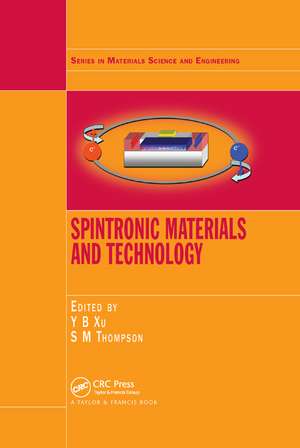Spintronic Materials and Technology
Editat de Yongbing Xu, Sarah Thompsonen Limba Engleză Paperback – 19 sep 2019
The second-generation spintronic devices discussed in Spintronic Materials and Technology will not only improve the existing capabilities of electronic transistors, but will enable future computers to run faster and consume less power.
Preț: 489.26 lei
Preț vechi: 575.60 lei
-15% Nou
Puncte Express: 734
Preț estimativ în valută:
93.62€ • 100.11$ • 78.06£
93.62€ • 100.11$ • 78.06£
Carte tipărită la comandă
Livrare economică 18 aprilie-02 mai
Preluare comenzi: 021 569.72.76
Specificații
ISBN-13: 9780367390075
ISBN-10: 0367390078
Pagini: 423
Dimensiuni: 156 x 234 x 36 mm
Greutate: 0.45 kg
Ediția:1
Editura: CRC Press
Colecția CRC Press
ISBN-10: 0367390078
Pagini: 423
Dimensiuni: 156 x 234 x 36 mm
Greutate: 0.45 kg
Ediția:1
Editura: CRC Press
Colecția CRC Press
Public țintă
Professional Practice & DevelopmentCuprins
Spintronic Materials and Characterizations. Magneto-Optical Studies of Magnetic Oxide Semiconductors. Synthesis and Characterization of Wide Band-Gap Semiconductor Spintronic Materials. Magnetic Properties of (Ga,Mn)As. Soft X-Ray Resonant Magnetic Scattering from Magnetic Nanostructures. The Effect for Ru Magnetization Switching and CPP-GMR Enhancement. The Spin Dependent Interfacial Transparency. Spin Torque and Domain Wall Magneto Resistance. Current-Driven Switching of Magnetization—Theory and Experiment. Domain Wall Scattering and Current-Induced Switching in Patterned Ferromagnetic Devices. Domain Wall Magnetoresistance in Magnetic Nanowires. Introduction to a Theory of Current-Driven Domain Wall Motion. Spin-Injection and Spin Devices. Silicon-Based Spin Electronic Devices: Toward a Spin Transistor. Spin-LEDs: Fundamentals and Applications. Spin Photo-Electronic Devices Based on Fe and the Heusler Alloy Co2MnGa. Ballistic Spin Tranport across a Schottky Barrier Induced by Photoexcitation. Ferromagnetic Metal/III-V Semiconductor Hybrid Spintronic Devices. The Spin-Valve Transistor.
Descriere
The second-generation spintronic devices discussed in this book will not only improve the existing capabilities of electronic transistors, but will enable future computers to run faster and consume less power. Merging the obstacles and recent technological advances in developing spin-controlled devices into one source, this expert-contributed work discusses underlying theory, experimental results, characterization techniques, and device applications. It also addresses the classes of materials systems with potential use in spintronics, such as ferromagnetic metals and alloys, Heusler alloys and half-metallic oxides, and diluted magnetic semiconductors.
